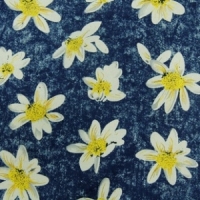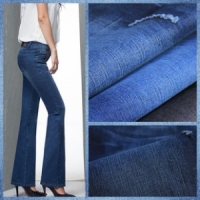According to the structure and characteristics of indigo dye, the structure of indigo dye can be destroyed by the chemical action of reductant or oxidant, and the purpose of drawing printing can be achieved. The oxidation and reduction reactions are as follows: reducing white carving powder and white bite agent w[1] are used as the dye drawing agent for the reduction drawing printing. Under the alkaline condition, after steam steaming, the strong reduction effect of white carving powder can reduce indigo to colorless cryptochrome, and then form alkali soluble orange yellow product with white bite agent W. after washing, the purpose of reducing and drawing printing can be achieved. The reduction drawing process has no damage to the strength of the fabric, but it has the disadvantages of low brightness, yellowing, complex preparation of the dyeing pulp, more amount of dye pulling agent, poor stability, high printing cost and low economic benefit.
Sodium chlorate and sodium Huangshan were used as the dye extractants in the oxidation drawing printing. Under the condition of acid, sodium chlorate will produce strong oxidation effect after steam steaming, which breaks the conjugated double bond in indigo dye structure and is oxidized to indigo soluble in alkali. It can be removed by alkali washing and soap washing to achieve the purpose of oxidation dyeing printing. The main problem of this process is that the brittle damage of cotton fiber is easy to occur in the presence of oxidant and acid agent. Therefore, the composition of oxidation dye extractant should be optimized, the dyeing pulp should be prepared according to the reasonable proportion, the appropriate technological conditions should be formulated, the operation strictly controlled, and the dyeing effect of printed denim should be considered, so as to make the strength retention rate of denim reach about 90%. Oxidation drawing printing has the advantages of good brightness, simple and quick preparation, controllable process conditions, less amount of dye extractant and low printing cost.
Composition of oxidation dye extractant
[2] Sodium chlorate with strong oxidation was selected as the main part of the dye drawing agent, and sodium yellow blood salt as oxygen conducting agent; Citric acid was used as catalyst for oxidation reaction to prepare the dye drawing pulp according to the reasonable ratio. In the presence of sodium Huangshan and citric acid, sodium chlorate can react rapidly and destroy indigo color and achieve the purpose of oxidation and dyeing printing. Oxidation and dyeing printing process of indigo denim [3-5]
2.1 process flow indigo denim → pre printing → printing → drying (105 ℃) → steam (100-101 ℃) × About 8min) → baking (130-135 ℃) × 2-4min) → water wash → drying
2.2 The Indigo Denim treated before printing contains cellulose co organism, slurry, floating color and caustic soda, which is not conducive to printing. Indigo denim cloth is not resistant to chlorine and alkali, and also can not be heaped with high temperature and wet heat. Only enzyme desizing is used. The use of penetrating agent JFC as desizing aids can improve the dosage of JFC, accelerate the desizing speed, improve the desizing rate and the wool effect of denim, and ensure the printing quality. The technological process of enzymatic desizing: first, it is washed by 70-80 ℃ 4 grid hot water (pre washing to remove caustic soda) → enzyme desizing (amylase 3g/l, salt 5g/l, penetrant jf3g/l, acetic acid adjust pH value to 6, temperature 55-60 ℃) → stack (temperature 55-60 ℃, time about 50min) → 4 grid hot water washing (above 95 ℃) → cold water washing → drying quality requirements: desizing is clean, pH value is neutral, gross effect is 8cm/30min.
2.3 composition and preparation of dye drawing pulp
2.3.1 composition of dye drawing pulp
(1) White pulp /% sodium chlorate, 8 sodium yellow blood salt, 3.2 citric acid, 4.8 urea, 5 acid resistant paste x
(2) Paint coloring and dyeing pulp /% sodium chlorate 8 sodium yellow blood salt
3.2 citric acid 4.8 urea 5 coating y adhesive 15 thickener Z
2.3.2 cold method is used to prepare the dye drawing pulp. The direct input method is used for feeding. It is convenient and quick to operate, which is conducive to the current use of the dye drawing pulp, and can reduce the loss of the dye extractant and reduce the escape of irritating gas. First, take a proper amount of acid resistant raw paste, stir it, and add the following: ① urea, ② sodium yellow blood salt, ③ sodium chlorate, ④ citric acid. The material shall be sprinkled slowly during feeding, and after dissolution, the next material shall be added. Citric acid shall be added before the dye is ready for use. The preparation method of color drawing pulp is the same as that of direct printing paste. It is advisable to control the viscosity of the dye drawing pulp at 50-60dpa · s. As the stability of the dye drawing pulp decreases with the increase of temperature, the remaining pulp after printing should be stored in a cool and ventilated place. If it is used again, the dyeing effect shall be checked first.
2.4 analysis of the components of the dye drawing pulp
2.4.1 sodium chlorate is the main component of the oxidation dye extractant, and its dosage depends on the indigo blue color depth, type of printed fabric, printing area, sizing amount and overprint. Sodium chlorate is an important guarantee of the quality of the printing. If the amount is insufficient, the drawing effect will be reduced, too much, the strength retention rate of denim will be reduced.
2.4.2 sodium yellow blood salt is the oxygen guide of sodium chlorate, which can accelerate the oxidation reaction and enhance the oxidation effect. Sodium Huangshan is an alkaline compound, which has a good buffer effect, and can effectively prevent the brittleness of denim caused by low pH value. The amount of sodium Huangshui depends on the amount of sodium chlorate, and the ratio of sodium chlorate to sodium Huangshui is 1:0.4.
2.4.3 citric acid must be added as catalyst for oxidation reaction in order to make oxidation and dyeing smoothly, and ensure that the pH value of citric acid is kept in a certain acid range during steam evaporation to accelerate oxidation reaction. Citric acid in a certain concentration range will not cause brittle damage of denim under moderate drying and steam steaming conditions; However, too much citric acid and excessive drying and steam steaming will cause the brittleness of denim. The amount of citric acid is also determined by the amount of sodium chlorate, and the ratio of sodium chlorate to citric acid is 1:0.6.
2.4.4 urea has good moisture absorption, and the moisture absorption of the dyeing pulp can be improved and the dyeing effect can be improved during steam evaporation. Adding urea in color drawing can slow down the dehydration and conjunctive of adhesive and cause mesh blocking, but the amount of urea can not be too much, otherwise the printing fastness will be affected. Urea also has slow and weak reduction, and can protect the paint which is not resistant to drawing from oxidation and dyeing during steam evaporation, and prevent the discoloration. In addition, urea can reduce the brittleness of denim, reduce the release of corrosive substances, and effectively prevent the erosion of equipment under good exhaust conditions.
2.4.5 paste selected shall be oxidation resistant and acid resistant, and shall have good water holding, paste removal, compatibility and stability, and clear printing outline. In addition, it is necessary to be able to make the original paste by cold water and be suitable for cold preparation of the dye drawing pulp.
2.4.6 the oxidant contained in the pigment and draft printing pulp of paint paint will destroy the structure of some coatings and lose the original color. Because of the difference in structure of different brands of coatings, the paint should be tested for drawing resistance before use to ensure the quality of color drawing printing.
2.4.7 the adhesive requires good compatibility and stability of the binder to oxidant and citric acid, and has the properties of softness, high firmness and slow conjunctive. The low temperature adhesive is selected for this test.
2.4.8 the thickener is a synthetic thickener with high concentration, low solid content, strong thickening and good permeability, which can be compatible with adhesive and has good compatibility and stability with oxidation dye and citric acid.
2.5 process condition analysis
2.5.1 during drying, sodium chlorate in the dye pulp is easy to decompose at high temperature, so it is necessary to adopt mild drying conditions, and the temperature should be ≤ 105 ℃. Drying is only to remove the moisture in the dye pulp, never over drying or long drying, otherwise, too much loss of oxidation dye will affect the dyeing effect, resulting in crisp loss of denim, even combustion. When printing large area pattern, the dye drawing paste printed on the edge of cloth is easy to stick to the drying room guide belt. If there is too much accumulation, it is very easy to cause the damage of the guide belt during drying. Therefore, the guide belt should be washed with water in time to prolong the use time of the guide belt. When printing stops, the heat source of drying room shall be turned off immediately and the cloth inside the drying room shall be put out with guide tape. When drying and dropping cloth, strong blow drying shall be adopted to make the denim fully ventilated and cooled, and steam treatment shall be done in time.
2.5.2 different from the reduction draft printing, the air quantity in the steamer is not controlled for the oxidation draft printing, and the air quantity does not affect the quality of the dyeing. Steam steaming under saturated steam (temperature 100-101 ℃, time about 8min) can balance the dyeing effect and denim strength. If the drawing effect is not good and the strength retention rate of denim is high, it can be steamed again to improve the dyeing effect. The chemical reaction of the dye extractant is very complex during steam steaming. Besides the pulling effect, it will release corrosive substances, which will be corrosive to the steamer. Therefore, the exhaust air volume should be adjusted accordingly according to the printing area of the drawing printing to prevent excessive accumulation of corrosive substances in the steamer. This method can increase the steam consumption, but it can effectively prevent the corrosion of the steamer. Even after steam steam is finished, corrosive substances should be drained in time to protect the steamer from corrosion.
2.5.3 after baking, the low temperature adhesive shall have good color fastness. If the color fastness requirements are not met, the baking temperature and time can be adjusted according to the strength retention rate of denim.
2.5.4 after the oxidation and dyeing of washing, indigo dye is decomposed into yellow substance, dissolved in hot alkaline solution, and then boiled by soap, so that the yellow material and paste can be removed sufficiently to improve the brightness and dyeing effect. The comparison between oxidation and reduction of 3 oxidation and reduction is shown in Table 2. The oxidation drawing process is lower cost and simpler than traditional reduction dyeing, but it is necessary to protect the equipment from corrosion.
4 Conclusion
(1) The indigo denim was made of sodium chlorate and sodium Huangshan. The cold method was used to prepare the dye drawing pulp. The operation was simple and quick, the quality was stable, the amount of the dye was less, the printing cost was low and the economic benefit was remarkable.
(2) The printing denim with good drawing effect can be obtained by making the process conditions correctly and strictly controlling the operation. The strength retention rate can reach about 90%.










